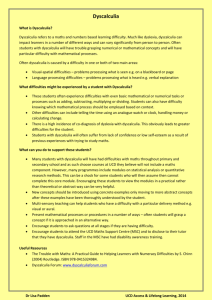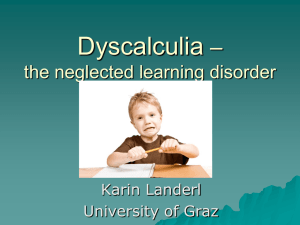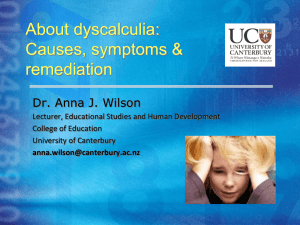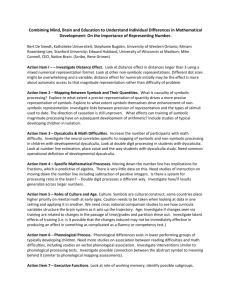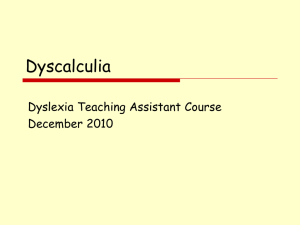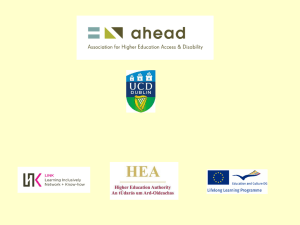PDF version
advertisement
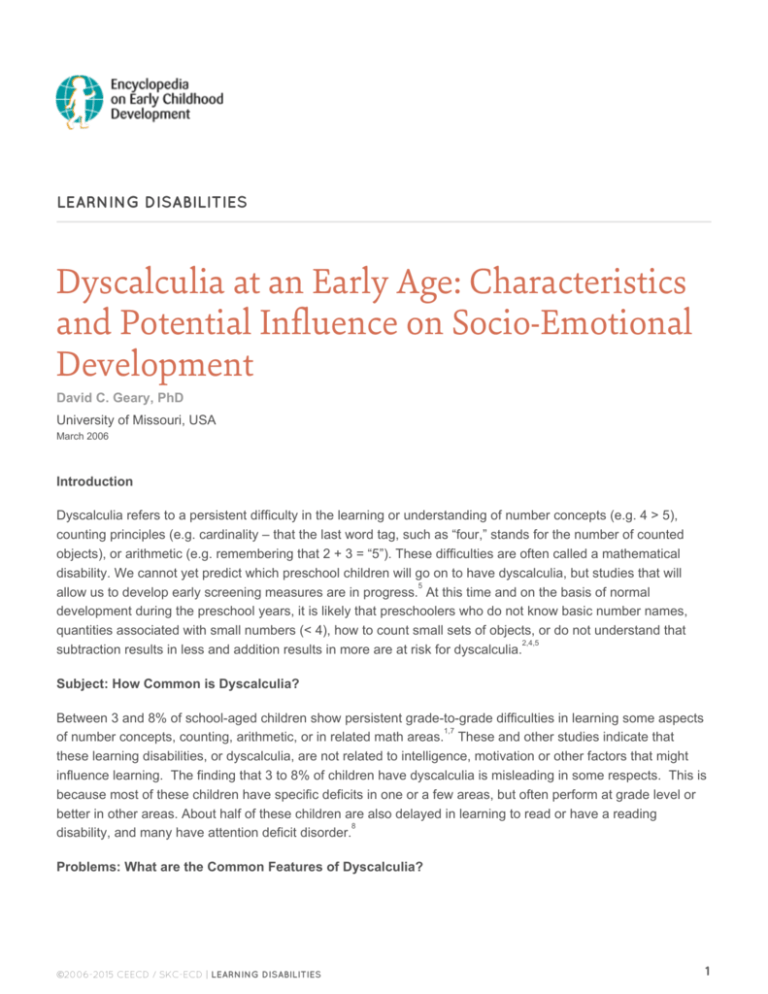
LEARNING DISABILITIES Dyscalculia at an Early Age: Characteristics and Potential Influence on Socio-Emotional Development David C. Geary, PhD University of Missouri, USA March 2006 Introduction Dyscalculia refers to a persistent difficulty in the learning or understanding of number concepts (e.g. 4 > 5), counting principles (e.g. cardinality – that the last word tag, such as “four,” stands for the number of counted objects), or arithmetic (e.g. remembering that 2 + 3 = “5”). These difficulties are often called a mathematical disability. We cannot yet predict which preschool children will go on to have dyscalculia, but studies that will 5 allow us to develop early screening measures are in progress. At this time and on the basis of normal development during the preschool years, it is likely that preschoolers who do not know basic number names, quantities associated with small numbers (< 4), how to count small sets of objects, or do not understand that 2,4,5 subtraction results in less and addition results in more are at risk for dyscalculia. Subject: How Common is Dyscalculia? Between 3 and 8% of school-aged children show persistent grade-to-grade difficulties in learning some aspects 1,7 of number concepts, counting, arithmetic, or in related math areas. These and other studies indicate that these learning disabilities, or dyscalculia, are not related to intelligence, motivation or other factors that might influence learning. The finding that 3 to 8% of children have dyscalculia is misleading in some respects. This is because most of these children have specific deficits in one or a few areas, but often perform at grade level or better in other areas. About half of these children are also delayed in learning to read or have a reading 8 disability, and many have attention deficit disorder. Problems: What are the Common Features of Dyscalculia? ©2006-2015 CEECD / SKC-ECD | LEARNING DISABILITIES 1 Some general conclusions can be made about the basic number, counting and arithmetic skills of children with dyscalculia. As stated, screening measures that predict which preschool children will have these problems in school are not yet available. However, as stated, it is likely that preschoolers who do not know basic number names, quantities associated with small numbers (< 4), how to count small sets of objects, or do not understand 5 simple addition and subtraction are at risk. Research Context and Recent Research Results Number In first grade, children with dyscalculia often do not know basic number names (e.g. “9” = “nine”), and have difficulty discriminating which number is larger or smaller. They will typically know that 3 is more than 2, but not know that 9 is more than 8. However, many of these children catch up in these areas of number understanding, at least for simple numbers. Counting Learning the basic counting sequence, "one, two, three and four …" is not difficult; almost all children learn this sequence, including most children with dyscalculia. What is important is that children learn the basic rules that underlie the ability to count effectively. These rules include One-one correspondence (one and only one word tag, e.g. "one," "two" is assigned to each counted object); stable order (the order of the word tags is the same across counted sets); and cardinality (the value of the final word tag represents the quantity of items in the counted set). Children’s understanding of these rules emerges during the preschool years, but they also must come to understand that counting can be done correctly in ways that differ from the typical. For instance, children will often observe adults counting from left-to-right and counting each item in order. As a result, many children come to believe that you must count in exactly this way. By second grade, most children understand that counting is more flexible, but for children with dyscalculia this understanding is delayed by one or two years. Arithmetic 3, 6 The basic arithmetic skills of children with dyscalculia have been extensively studied. These studies, which have focused on how children solve simple arithmetic problems (e.g. 4 + 5 =?), such as finger counting or remembering the answer, have revealed several very consistent patterns: First, many children with dyscalculia have difficulties remembering basic arithmetic facts, such as the answers 6 to 5+3. It is not that these children do not remember any arithmetic facts, but rather that they cannot remember as many facts as other children do and appear to forget facts rather quickly. Second, many of these children use immature problem-solving strategies. For example, they rely on finger counting for more years than other 3 children, and they make more mistakes when counting. Key Research Questions: Socio-Emotional Development This is an area in which there is very little research. However, we now understand that anxiety about ©2006-2015 CEECD / SKC-ECD | LEARNING DISABILITIES 2 mathematics can lead to errors, because thoughts about how well you are doing can intrude into consciousness 2 and disrupt mathematical problem-solving. Although math anxiety does not typically emerge until the middle of the elementary school years, dyscalculia is very likely to eventually result in frustration, avoidance and potentially excess anxiety when having to solve math problems. Any such anxiety will be in addition to the underlying cognitive deficit and will almost certainly make the learning of mathematics even more difficult. Conclusions Between 3 and 8% of school-aged children will show evidence of dyscalculia. The early signs of this form of disability include a poor understanding of number magnitude (e.g. that 8 < 9), a rigid understanding of counting, and use of immature strategies during problem-solving. One of the most common and long-term problems is difficulty remembering basic arithmetic facts (e.g. 4+2 = “6”). These children are likely to be at risk for development of math anxiety, which will lead to avoidance of mathematics and make the acquisition of basic skills in this area even more difficult. Implications: Where Do We Go from Here? There is much that needs to be done is this area in terms of basic research, assessment and diagnosis, and, of course, remediation. Basic research There are more unanswered than answered questions in this area. We need to know more about basic 5 counting and arithmetic skills in preschool children as this relates to later risk of dyscalculia. We need to learn 8 more about the genetics of dyscalculia and the neurological systems that might be involved. We need to know more about the co-occurrence of reading and math problems, and how these problems may relate to risk of math anxiety and school avoidance. Diagnosis and Remediation A standardized diagnostic test that provides more precise information on counting knowledge, counting procedures used to solve arithmetic problems, the ability to remember facts, and so forth is needed for elementary school children with dyscalculia, as is a corresponding measure for identifying preschool children 5 who might be at risk. Unfortunately, there is little research on effective instructional techniques that remediate this learning difficulty. Socio-Emotional Functioning In addition to remediation for the cognitive deficits associated with dyscalculia, the anxiety and avoidance of mathematics that is likely to result from these deficits needs to be addressed. Without attention to the frustration and anxiety that is likely to be associated with dyscalculia, a risk for exacerbated and long-term problems in math exists. References 1. Badian NA. Dyscalculia and nonverbal disorders of learning. In: Myklebust HR, ed. Progress in learning disabilities. Vol 5. New York, NY: ©2006-2015 CEECD / SKC-ECD | LEARNING DISABILITIES 3 Grune & Stratton; 1983:235-264. 2. Geary DC. Children's mathematical development: research and practical applications. Washington, DC: American Psychological Association; 1994. 3. Geary DC. Mathematics and learning disabilities. Journal of LearningDisabilities 2004;37(1):4-15. 4. Geary DC. Development of mathematical understanding. In: Kuhl D, Siegler RS, eds. Cognition, perception, and language. New York, NY: John Wiley and Sons. Damon W, ed. Handbook of child psychology. 6th ed; vol 2. In press. 5. Gersten R, Jordan NC, Flojo JR. Early identification and interventions for students with mathematics difficulties. Journal of Learning Disabilities 2005;38(4):293-304. 6. Jordan NC, Hanich LB, Kaplan D. Arithmetic fact mastery in young children: A longitudinal investigation. Journal of Experimental Child Psychology 2003;85(2):103-119. 7. Kosc L. Developmental dyscalculia. Journal of Learning Disabilities 1974;7(3):164-177. 8. Shalev RS, Manor O, Gross-Tsur V. The acquisition of arithmetic in normal children: Assessment by a cognitive model of dyscalculia. Developmental Medicine and Child Neurology 1993;35(7):593-601. ©2006-2015 CEECD / SKC-ECD | LEARNING DISABILITIES 4
